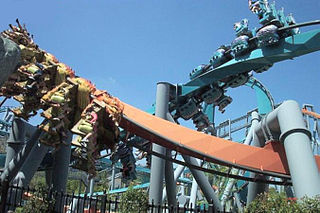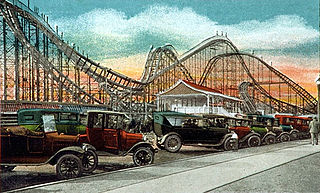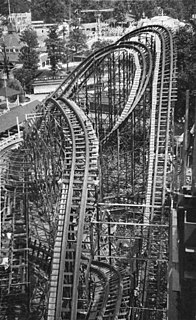
A wooden roller coaster is a type of roller coaster classified by its wooden track, which consists of running rails made of flat steel strips mounted on laminated wood. The support structure is also typically made of wood, but may also be made of steel lattice or truss, which has no bearing on a wooden coaster's classification. The type of wood often selected in the construction of wooden coasters worldwide is southern yellow pine, which grows abundantly in the southern United States, due to its density and adherence to different forms of pressure treatment.

A steel roller coaster is a roller coaster that is defined by having a track made of steel. Steel coasters have earned immense popularity in the past 50 years throughout the world. Incorporating tubular steel track and polyurethane-coated wheels, the steel roller coasters can provide a taller, smoother, and faster ride with more inversions than a traditional wooden roller coaster.

Philadelphia Toboggan Coasters (PTC) is one of the oldest existing roller coaster manufacturing companies in the world. Based in Hatfield, Pennsylvania, it was established in 1904 by Henry Auchey and Chester Albright under the name Philadelphia Toboggan Company. The company manufactured carousels, wooden roller coasters, toboggans and later, roller coaster trains.
A cyclone is an area of closed, circular fluid motion characterized by inwardly spiraling winds.
John A. Miller was an American roller coaster designer and builder, inventor, and businessman. Miller patented over 100 key roller coaster components, and is widely considered the "father of the modern high-speed roller coaster." During his lifetime, he participated in the design of approximately 150 coasters and was a key business partner and mentor to other well-known roller coaster designers, Harry C. Baker and John C. Allen.

Chance Rides Manufacturing is a roller coaster and amusement ride manufacturer. The company was formed on May 16, 2002, when the former Chance Industries Inc. emerged from bankruptcy. The main office and manufacturing facility are located in Wichita, Kansas.

Gerstlauer Amusement Rides GmbH is a German manufacturer of stationary and transportable amusement rides and roller coasters, located in Münsterhausen, Germany.

The Cyclone was a wooden roller coaster that operated at Revere Beach in Revere, Massachusetts, from 1925 until 1969. When Cyclone was constructed, it was the tallest roller coaster ever built, as well as being the first roller coaster in the world to reach 100 feet (30 m) in height. In addition to being the tallest roller coaster of its day, some also claim that it was the largest and fastest roller coaster in the world, with a length of 3,600 feet (1,100 m) and top speeds between 45 and 50 mph. Cyclone held the title of world's tallest roller coaster until 1964 when it was surpassed by Montaña Rusa at La Feria Chapultepec Mágico in Mexico City, Mexico.

Lightning was a wooden roller coaster that operated from 1927 until 1933 at Revere Beach in Revere, Massachusetts. It was one of the infamous Giant Cyclone Safety Coasters which were constructed by noted roller coaster engineer Harry G. Traver in the mid-1920s. Lightning was the only Giant Cyclone Safety Coaster not to bear the "Cyclone" name, as a roller coaster named Cyclone already existed at Revere Beach when Lightning was constructed in 1927. The other two members of this group of coasters included the Crystal Beach Cyclone and the Palisades Park Cyclone.
Frederick A. Church (1878–1936) was an American engineer and early roller coaster designer. He is most famous for his "Bobs" series of roller coasters that featured severe banking, steep drops, and nonstop action.

Jupiter is a wooden roller coaster at Kijima Kogen, an amusement park in Beppu, Ōita Prefecture, Japan.

Backety-Back Scenic Railway was a wooden roller coaster located at Crystal Beach Park. The ride opened to the public in 1909 and operated until 1926. The Backety-Back Scenic Railway was notable for a backward-traveling innovation which would be adopted many years later in more modern steel roller coasters. It was also one of the earliest shuttle roller coasters to be built, as well as being the second roller coaster to be built in the Crystal Beach amusement park. The coaster has been cited as a particularly beautiful example of roller coaster architecture.
Harry C. Baker was an American entrepreneur most notable for his involvement with the building of roller coasters. Through partnerships and later, as president of the Harry C. Baker Company, Baker would be involved with notable designs such as the Cyclone at Coney Island, the Blue Streak at Woodcliffe Pleasure Park, and the Kennywood Park Jack Rabbit.
Vernon Keenan was an American roller coaster designer best known for his involvement with the Cyclone at Coney Island.
Jazz Railway was an early model line of wood roller coasters incorporating a steel-frame structure. These operated at various amusement parks and fairgrounds during the mid to late 1920s. The coaster model is considered to be the first of the Wild Mouse style roller coaster.

Cyclone was the name of two wooden roller coasters which operated at Palisades Amusement Park in Bergen County, New Jersey. The first operated from 1927 through 1934, and the second between 1945 and 1971.
Zip or Zipp was a steel-framed wooden roller coaster which operated at Oaks Amusement Park in Portland, Oregon. The coaster was a more compact variant of the Giant Cyclone Safety Coasters which were built by Harry Traver of the Traver Engineering Company in the mid to late 1920s.

Thunderbolt was a wooden roller coaster which operated at Savin Rock Amusement Park in West Haven, Connecticut, from 1925 until 1938 when it was destroyed by a hurricane. It was rebuilt in modified form in 1939 and it continued to operate until 1956. When it was first built, it was purported to be the fastest roller coaster in the world.
Giant Cyclone Safety Coasters were a model line of roller coasters designed and marketed by Harry Traver and his company Traver Engineering in the 1920s. Despite their name, they had a reputation of being dangerous and are regarded by many historians as some of the most fearsome roller coasters ever built.

Airplane Coaster, known previously as the Aero-Coaster and the Aeroplane Dips, was a wooden roller coaster which operated at Playland Amusement Park in Rye, New York, from 1928 until 1957.













